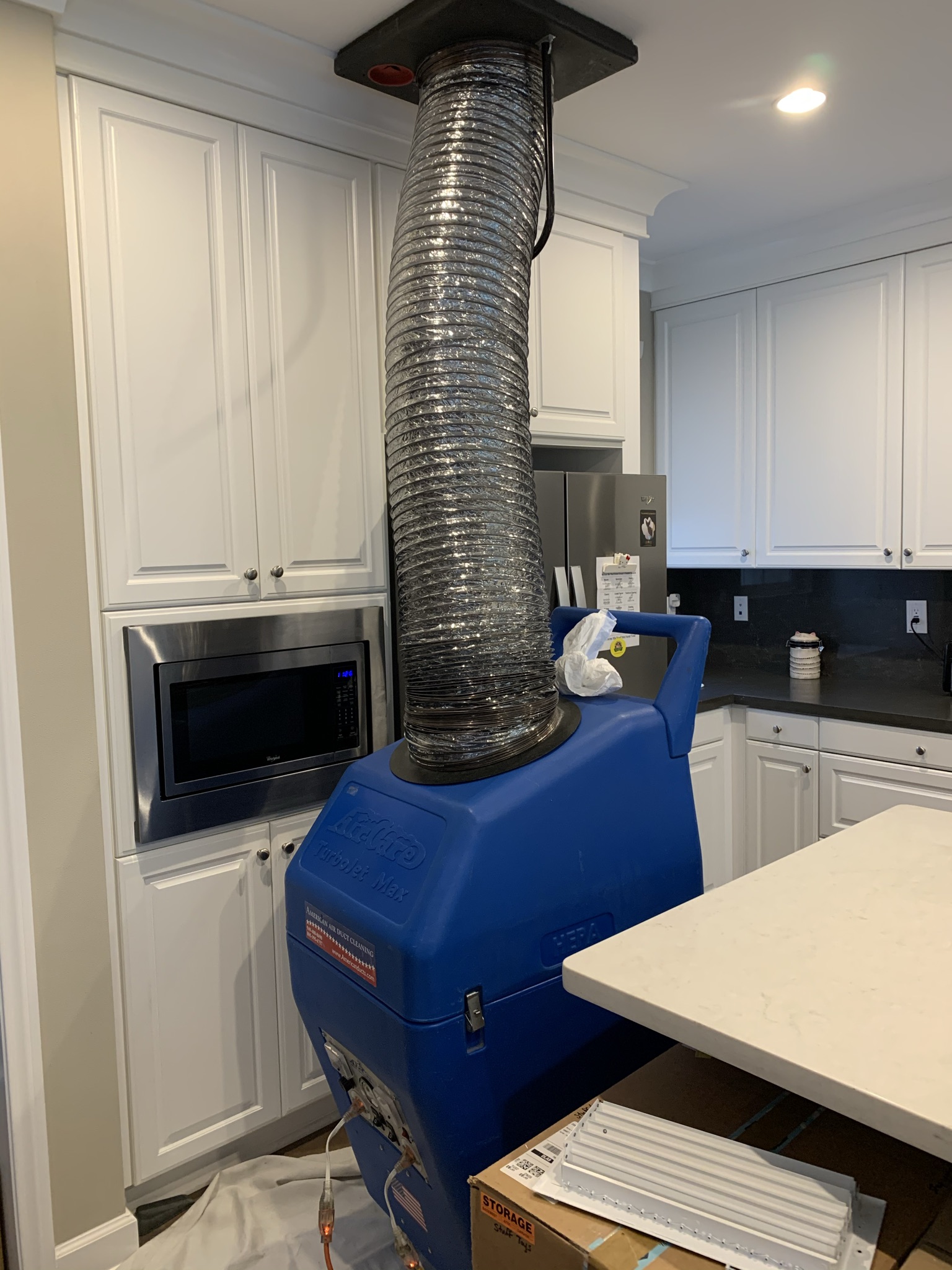Furnace Maintenance
Lot of backstory on this one! Feel free to skip ahead if you don’t want to read a wall of text.
When we moved into our house, one of the first things we noticed is that the whole house would get blanketed by a thin layer of dust every night that we used the AC, fan, or heat.
We had a somewhat similar issue in a past condo where the problem was that the dryer vent was supposed to go up through the roof. The problem was that our condo was getting covered in lint every time we used the fan/furnace. It ended up being that the insulated tubing that was supposed to be attached to the vent opening from the dryer in the ceiling was just sitting there, lying down in the attic, detached. Not good when your furnace is in the attic. An HVAC company came in and discovered and fixed that.
So! We called the same HVAC company from back then to help us diagnose our dust issue in our current house since we suspected something similar was happening. We also had them do some cleaning on our ducts, because we’ve noticed that our previous house owner didn’t seem to be a fan of doing the dirty maintenance jobs (plumbing, HVAC, etc). We should’ve been tipped off from the number of air purifiers she had setup all throughout the house when we were doing walkthroughs.

This was one of the first things the HVAC guys did when they showed up. Hooked up this giant inverter that pumped air back through our registers. Pretty neat!
Oh, this is a good time to explain that there are 2 types of vent openings in a house:
- Registers are those smaller steel (usually, sometimes plastic) covers. There’s typically one per room, sometimes 2. The house fan and/or furnace makes air flow out of these.
- Returns are those larger steel panels that you open up and put your MERV-8, 11, or 13 pleated air filters in. They’re called returns because air flows into those vents. This is why it’s crucial to line up the arrow on your filters such that the arrow is pointing toward the duct.
OK, so where’s the DIY part? Well, long story short, the HVAC contractor found the problem with our dust: there was TONS of blown-in insulation circling our furnace. Blown-in insulation are those little loose bits of fiberglass insulation that work really really well in an attic that doesn’t have a furnace in it, but are a terrible thing to have in an attic where the loose bits could get caught and blown throughout the house.
He got rid of a bunch of the loose insulation from the furnace, and also took out our super old, probably never changed furnace filter (a big 5 inch version of those pleated filters).
Here’s where the DIY starts
Our HVAC contractor took the panel covers off of our furnace but didn’t put them back on properly - he put them on backwards and drove some bolts into the panels because they weren’t sticking (again, because they were backwards). So, I set out to fix that, and I mean, I also needed to change the filter anyway.
Here’s the filter. Chonky boi. I actually ordered the size blindly, like an idiot. It could’ve either been 4 or 5 inches. The old filter didn’t have its size printed on it, for some reason. I went with 5 since that felt right haha.
Getting the tools ready. I actually had to buy an impact driver for this. I didn’t know what an impact driver was before this, but I deduced that that’s what he used to drive in the bolts in the panels. Learning is fun!
OK, more tools education time
- Impact Drivers are great for driving fasteners (screws, nuts, bolts). These don’t have a clutch the way drills do, and the bit holders on these are stubby and magnetic. Very easy to take bits on and off one handed, which is awesome. Yay for ergonomics! Impact drivers will also detect when resistance is being met and will start to sort of stop up and push back on you, letting you know you’ve gone far enough.
- Drill drivers (commonly known as drills) are great for drilling holes. They have an adjustable clutch to both hold bits and adjust force. There are also hammer drills that are great for harder surfaces like masonry.
- Due to the changeable bits, there is a lot of overlap these days between what an impact and drill driver can do. Moreso with drills being able to drive screws. But, drill bits for impact drivers is atypical and nut/bolt bits for drills is atypical.
My Werner folding ladder is only 6 ft, which isn’t tall enough, so I had to use my Gorilla telescoping ladder. Lots more painful to setup, but lots more flexible, of course!
A peek at the blown-in insulation mess on entry
Now, here’s what the furnace looked like before the HVAC contractor opened it up.
See all that loose insulation? That was the problem. Anyway…
Here’s how he left it:
Note the panels have swapped sides, AND the hand screws on the panel with the logo is backwards. That’s why he couldn’t get it to fit properly and ended up driving bolts into it. Close up:
You see, the way this furnace works (maybe all furnaces?) is that a button needs to be held down to keep it powered on. The button is underneath that panel. I probably should’ve gotten a photo of that, now that I think about it, oops.
But first things first, the filter. Oh, it’s worth mentioning that my furnace (and probably a lot of furnaces for newer construction) is both a house fan and a furnace, so it has a filter attached to it, which is actually a totally separate device. I found out that this is a Honeywell F100 Media Air Cleaner, funny story on that in a minute.
The filter fit perfectly. SUPER LUCKY! Note the direction of the arrow since this is the return path.
OK now back to fixing the panel. For some reason I didn’t take many progress photos of this even though I thought I did. Anyway, impact drivers are fun, so I guess I should thank my HVAC guy for messing this up lol.
Note that it’s flipped from its original orientation, but that’s ok. The reason the HVAC guy got it backwards was because the warning labels on the non-logo panel were up-side-down, originally, so he got confused. So I just made things make more sense.
So the funny story thing I mentioned. There was actually a manual for the filter lying top of the unit. Didn’t get a photo of that again, for some reason! There was another manual a little further in. Sorta felt like finding a hidden item in an RPG.
This drew my attention to these pieces of sheet metal holding the furnace down.
Well, for now my job was done, since I mostly did what I set out to do.
However, I was still sort of unsettled by how dangerous those pieces of metal were up there. I also read that it’s actually a good idea to duct tape the furnace panels in place and not leave too many air gaps since the air just escapes into the attic that way, making your HVAC less efficient. So I decided to make a return trip many weeks later.
I had a better strategy on dealing with the actually quite heavy drywall panel covering the attic. Label it with my phone in a photo and leave it on the ground instead of pushing it into the attic.
Tools for the return trip.
The screwdrivers were for a separate project. I wanted to check out the light up there (a CFL) since I want to convert the whole house to LED. Anyway, the knife was going to be for cutting the old tape since there was a lot of old melted tape up there. The chisels were supposed to be for smoothing out the metal.
Here’s some of the old duct tape
This part isn’t super entertaining. I just had to make a lot of awkward cuts to get the duct tape to fill the gaps.
Finished taping
Smoothing out the jagged sheet metal ended up being a DIY Fail. Here’s where I started.
And here’s the result
I did a bit more research and got some aviation snips and emery cloth. I think those will be more effective
